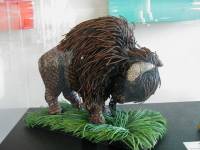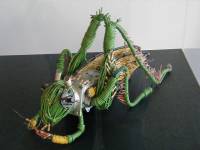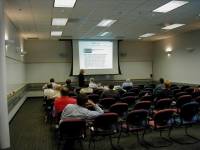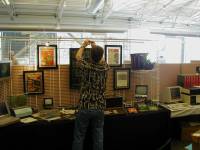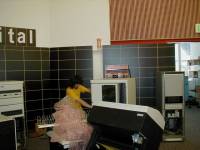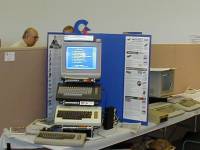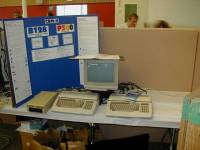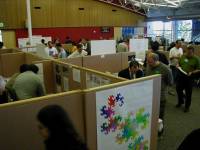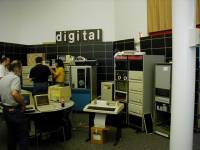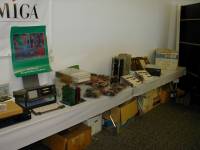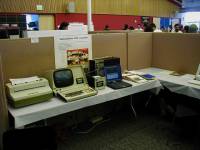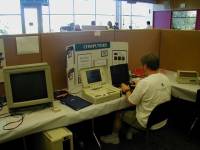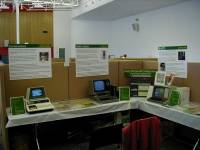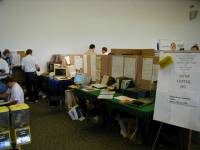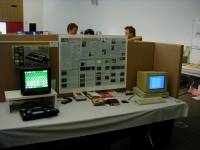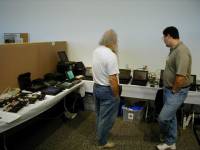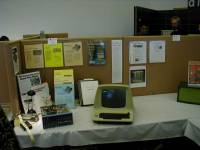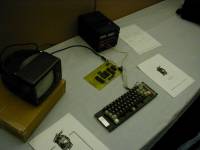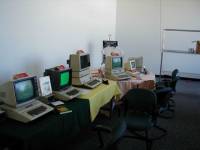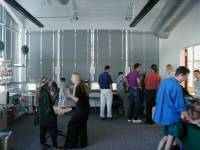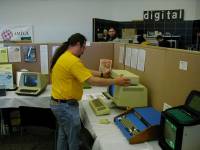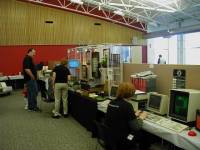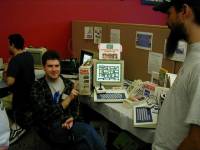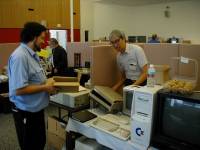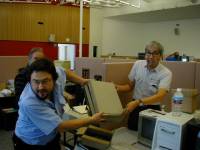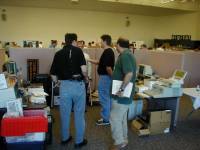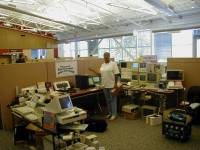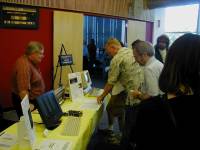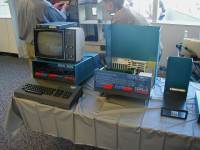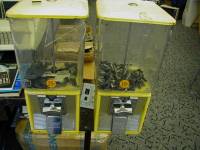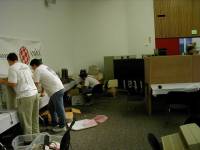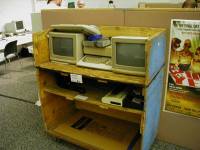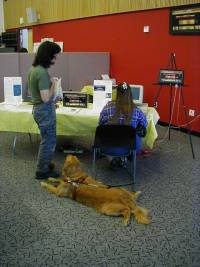Table of Contents
THE VINTAGE COMPUTER FESTIVAL 6.0
Oct. 11 & 12th, 2003
A wonderful annual event for west coast nerds is the Vintage Computer Festival, created by Sellam Ismal, celebrates classic computers and the people who collect and preserve them.
2003's West Coast Vintage Computer Festival was held at the new permanent location of the Computer History Museum in Mountain View California.
As an exhibitor - my brother and I travel over the Altamont, down the bay and arrive the night before to stay at a nearby motel (sure saves headaches on trying to keep a schedule in Bay Area traffic!)
The next day we go to the site early to set up. The Computer History Museum building, formerly built for Silicon Graphics Inc. is a wondrous design of glass and steel, truly makes a statement as many museums of art and technology do. Add to that the fascinating displays of computer history through the decades, it is worth a trip with a camera (I didn't do the tour this year, but I have pictures from my tour last year on my VCF 5 page).
Back to setup. The VCF exhibits don't officially open till 2:00pm, (the show opens at 10:00am and begins with various lectures [pic] and tours of the CHM) so it gives presenters several hours to get our displays assembled, meet fellow presenters and vendors, as well as grab a bite of lunch. One of the most challenging display setups was Paul Zachary & Guy Sotomeyer's Digital Equipment Display, Another display was totally the opposite (forgot to click a picture) an impressive handheld/palmtop display by Evan Koblentz which all fit in his briefcase.
Once my display was set-up (a 'commodore breadbox' and multimedia reminiscence featuring the Commodore VIC-20, C-16 and Commodore 64 all of which used the same case design - along with a DVD player to play Commodore commercials for when I needed to leave it unattended. [available on commodorebillboard.de also as a compilation CD from Individual Computers - CD proceedes benefit the Commodore Billboard project, also available is the funet.fi Commodore files archive CD] The other part of the display was my two Commodore CBM II series computers a B-128 and the rare P500 [P-500 page], we could help others and look about at the other exhibits.
Here is a rundown of the other exhibits that I got good pictures of during the two days:
Paul Zachary & Guy Sotomeyer's (really running!) Digital Equipment 'big iron' display. (Paul's display deservedly won the “Best of Show” honor)
Bill Bosari and Dale Luck's Amiga Display (including rare prototype Lorraine boards and an Amiga 500 in an SX-64 style case!)
Jim Battle's Wang System 2200 Computer
Stan Sieler's PA-RISC Laptops
Eric Klien's classics of computing, PET-2001, MITS Altair and TRS-80 (model 1)
Liza Loop's Lo*op Center - a forward thinking computer education project ran in the bay area in the 70's-80's.
Tim Lindner's exciting Modern Intellivision display
Bob Borsari's GRiD Rugged Laptops
Larry Pezzolo's Altair 680 display (note the classic terminal and paper tape reader!), just to the edge is Tom Stall's Mark-8 - a finished computer from a project featured in the July 1974 Issue of Radio Electronics.
Gregor Glawitsch's “Replica I” - Apple I Clone. With modern chips it is much smaller then the original but runs all the programs. (Won an award for re-creation of technology… more replicas mentioned later!)
a refreshing look at Apple 8-bits (haven't been common at VCF)
I missed much of the Xerox Alto's 30th anniversary goings on at VCF this year. (the Alto was the computer system that pioneered the GUI ideas and technology now seen in Mac OS and Windows.) The DigiBarn provided several Xerox systems based on Alto technology running for attendees to experiment with.
Jordan Ruderman working on his Lisa 2/10, Sol-20 and Osborne Vixen display (also note the Apple e-Mate in front)
Robert Harker's Early Sun Workstations; Bill Gosper's Symbolics LISP Machine; and Stephen Jones' SDF Public Access UNIX System (whose display won several awards)
Last, but not least is Cameron Kaiser with his Tomy Tutor collection, featuring both the American and Japanese versions of the Tomy Tutor. (also won a couple awards)
Besides the exhibits there is a vendor area for fans to start or add to their collection (some are selling to thin theirs out a bit), some of the vendors:
Jet-setter, Robert Bernardo of the Fresno Commodore Users Group, straight from the Chicago SWRAP Commodore Expo the day before, had several Commodore computers for sale on Sunday, as well as displaying the odd 'Spartan Apple II expansion unit,' being admired by German Commodore fan Hans Franke (who was exhibiting also). Of course, sometimes the temptation is too much for us.
Marvin Johnston, collector, like many, probably selling as many items as he was buying.
Asale Kimaada another VCF long-time regular with lots of goodies to offer.
Bob Armstrong was selling a working recreation of a PDP-8 Panel and other goodies
the Imsai booth offered a recreation of the Imsai computer in case you missed your chance at buying one the first time.
Besides their impressive DEC exhibit Paul Zachery & Guy Sotomeyer also had vendor booths. One tempting me with a “Commodore” file cabinet (I barely resisted) and for the frugal shopper discount chips were offered in a convenient self-serve fashion [pic].
Programming Challenge
During the latter part of Sunday the 'Retro-Code Video Game Programming Challenge' was started again (delayed from Saturday due to power problems). From the VCF site: “The object is simple: write the best video game on your team's chosen computer within 3 hours. At the end of the coding period, the games will be judged by a panel of randomly chosen VCF attendees and the game most liked by attendees will be deemed the Retro-Code Champion!” Which is not always the easiest thing to do, as for time you are most-likely limited to BASIC and are only given the computer, some programming guides and an empty disk to store your program afterwards.
Last year I came in second, behind Jeri Ellsworth with her 'Pimp Sim' game. So I had experience coding in the time frame and thought a bit more about what good game concepts one could write.
I manned the versatile Commodore 64 - this day without Cameron Kaiser, my teammate to code alone (he could only attend VCF on Saturday). Competing was a Nigel from New Zealand on an Apple II, and Hans Franke and Eric Smith using two Apple IIgs' (considered by some an unfair advantage over the single-computer teams); the Atari 800 guy from the day before was a no-show, unfortunately. My game “Thrift Score” was a variation of the Activision classic Kaboom, but in this version you had a shopping cart at the bottom of the screen and attempted to catch computers that were falling, once you failed to catch five computers, you were then rated on the number of computers you successfully 'collected'. The Apple II game was a hexgrid board game which seemed remenicent to gomuku, and the IIgs team had whipped up a nice looking Maze (dungeon) exploration/combat game. Once the contest ended (fortunately, we all were able to create complete working games in that time) we had to demonstrate our game and let a play tester check it out and then vote. This year I was victorious. My award, a first issue of Byte Magazine (cool ads - and very informative articles for 1974!) and a small cash prize. Hopefully the entries will be available soon on the VCF page so you can judge for yourself.
Coding tips:
- Go for it - don't be afraid to try, think, how often do you get a chance to program in front of a curious audience?
- Think ahead of time what games you could do in the time frame - if you are not too comfortable on the machine, keep it simple, you probably are going to be limited to BASIC given most early computers didn't have built-in assemblers.
- Start coding with the hard essential stuff first, then work your way out to niceties.
- Know your computer's limitations and strengths, reasearch/practise it's BASIC, work with it; if you can code cool effect real cheaply (timewise) try to use it to make your game look more exciting.
- Try to make a good theme or uniqueness - even to an old idea - it will shine over me-too reproductions.
During the latter part of the programming challenge I took a break to watch the exhibit awards - many great displays received well deserved honors. My breadbox display won 'Best Presentation Research'.
End of the day
After the Programming and awards it was time to pack up. For some they come with less stuff then they bring, others, such as myself, had to find places to pack away the goodies I just couldn't leave without. One nice addition this year were those handy carts which made all the exhibitor's transporting of displays a breeze.
Once again VCF has done better then the year before, and is highly recommended to vintage computer enthusiasts to attend - sighted or otherwise (and display, and present). You'll meet some the nicest bunch of nerds in the Valley - along with plenty old computer stuff you can't buy just about anywhere.



